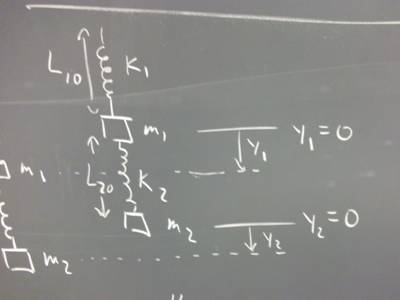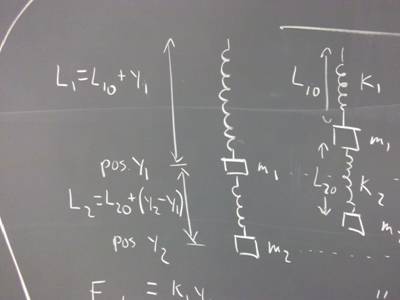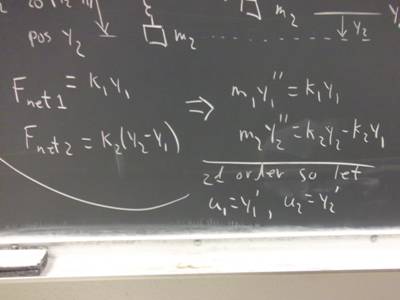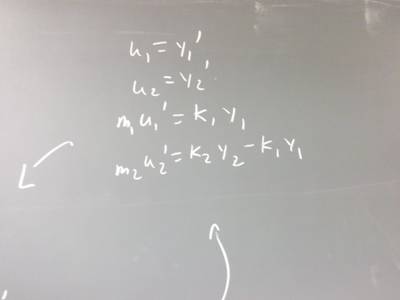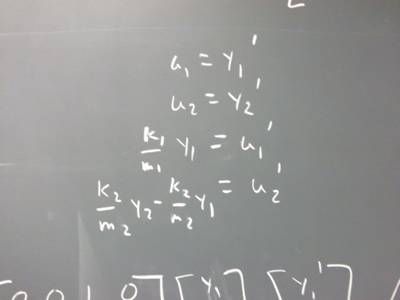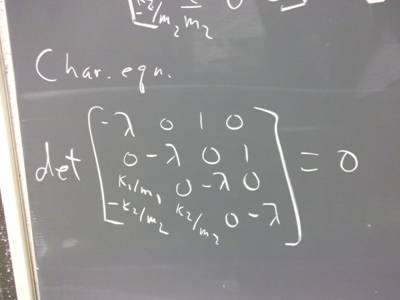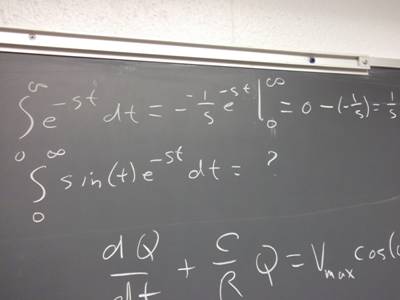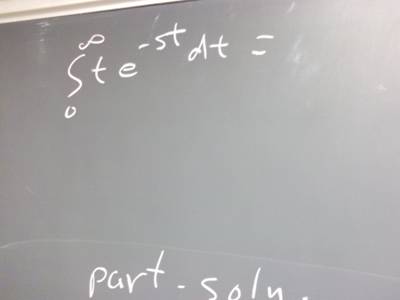
110330 Differential Equations
`q001. For the rabbits and foxes model of the preceding class, find the slope at the point (200, 10 000). Sketch this slope on a graph of R vs. F, taking into account the difference in the scales of your two axes.
****
#$&*
Find the lines and/or curves on the R vs. F graph for which dR/dt is zero. Sketch these curves, and sketch a number of horizontal direction-field lines along each.
****
#$&*
Find the lines and/or curves on the R vs. F graph for which dF/dt is zero. Sketch these curves, and sketch a number of vertical direction-field lines along each.
****
#$&*
10 000 on your R scale will probably be about as big as 200 on your F scale, meaning that the R scale is about 50 times your F scale. If so, what appears to be a 45 degree line segment on your graph actually represents a slope of 50.
Find the line or curve for which dR/dt is 50 times as great as dF/dt, and of opposite sign (i.e., the curve for which dR/dt / (dF/dt) = -50).. Sketch that line or curve, and sketch the corresponding slope segments.
****
#$&*
Here are some approximate values of the slope:
On the vertical line F = 150, the slopes at R = 5000, 10 000 and 15 000 are about -40, -330 and +221, respectively.
On the vertical line F = 200, the slopes at R = 5000, 10 000 and 15 000 are about -20, -165 and +110, respectively.
On the vertical line F = 250, the slopes at R = 5000, 10 000 and 15 000 are about -10, -65 and +43, respectively.
This should help you see the trend of the slope field (take scaling into consideration).
Using this information and the information obtained earlier, sketch a rough solution curve that passes through the point (200, 10 000), and describe how the populations of rabbits and foxes change, starting from that point and continuing through a complete cycle.
****
#$&*
Sketch also a rough solution curve that passes through the point (100, 12 000), and describe how the populations of rabbits and foxes change, starting from that point and continuing through a complete cycle.
****
#$&*
Compare the behavior of the rabbit-fox population for the two curves.
****
#$&*
Do you think the curves actually close? Is it possible that they spiral in toward some central point? Or that they spiral outward away from that point? Or do they perhaps approach some curve, perhaps but not necessarily an ellipse?
****
#$&*
What would these different behaviors of the solution curves imply about the long-term behavior of the populations?
****
#$&*
`q002. Mass m_1 is suspended from a spring with force constant k_1, and m_2 is suspended from a spring with force constant k_2, attached to mass m_1. Write the system of equations that models y_1 and y_2, the respective displacements of the two masses from their original equilibrium positions.
****
#$&*
Since the net force on each mass is proportional to the second derivative of its position function, the equations for y_1 and y_2 are both second-order. We can get around that by introducing two new variables u_1 = y_1 ' and u_2 = y_2 '.
Rewrite the system as a system of four equations in y_1, y_2, u_1 and u_2.
****
#$&*
Write the system as a matrix equation.
****
#$&*
Find the equation we need to solve to obtain eigenvalues of this matrix.
****
#$&*
What are the meanings of u_1 and u_2 in terms of the spring-mass system?
****
#$&*
`q003. The differential equation that governs an RC circuit is I * R + C * Q - V =
0, where V is the voltage of the source, R is the resistance of the resistor,
and C is the proportionality constant that relates the charge on the capacitor
to the voltage it produces. The current I is the rate at which charge is being
accumulated by the capacitor, so I = dQ/dt..
If V is constant, what is the solution to the equation?
****
#$&*
If V = V_max * sin ( omega * t) then what is the solution to the equation?
****
#$&*
`q004. The differential equation that governs an RLC circuit is L * dI/dt + I * R +
C * Q - V = 0.
If V is constant, what is the solution to the equation?
****
#$&*
If V = V_max * sin ( omega * t) then what is the solution to the equation?
****
#$&*
`q005. Find the following:
integral(e^(- s t) dt, t from 0 to infinity)
****
#$&*
integral(sin(t) * e^(- s t) dt, t from 0 to infinity)
****
#$&*
integral(cos(t) * e^(- s t) dt, t from 0 to infinity)
****
#$&*
integral(t * e^(- s t) dt, t from 0 to infinity)
****
#$&*
integral(t^3 * e^(- s t) dt, t from 0 to infinity)
****
#$&*













